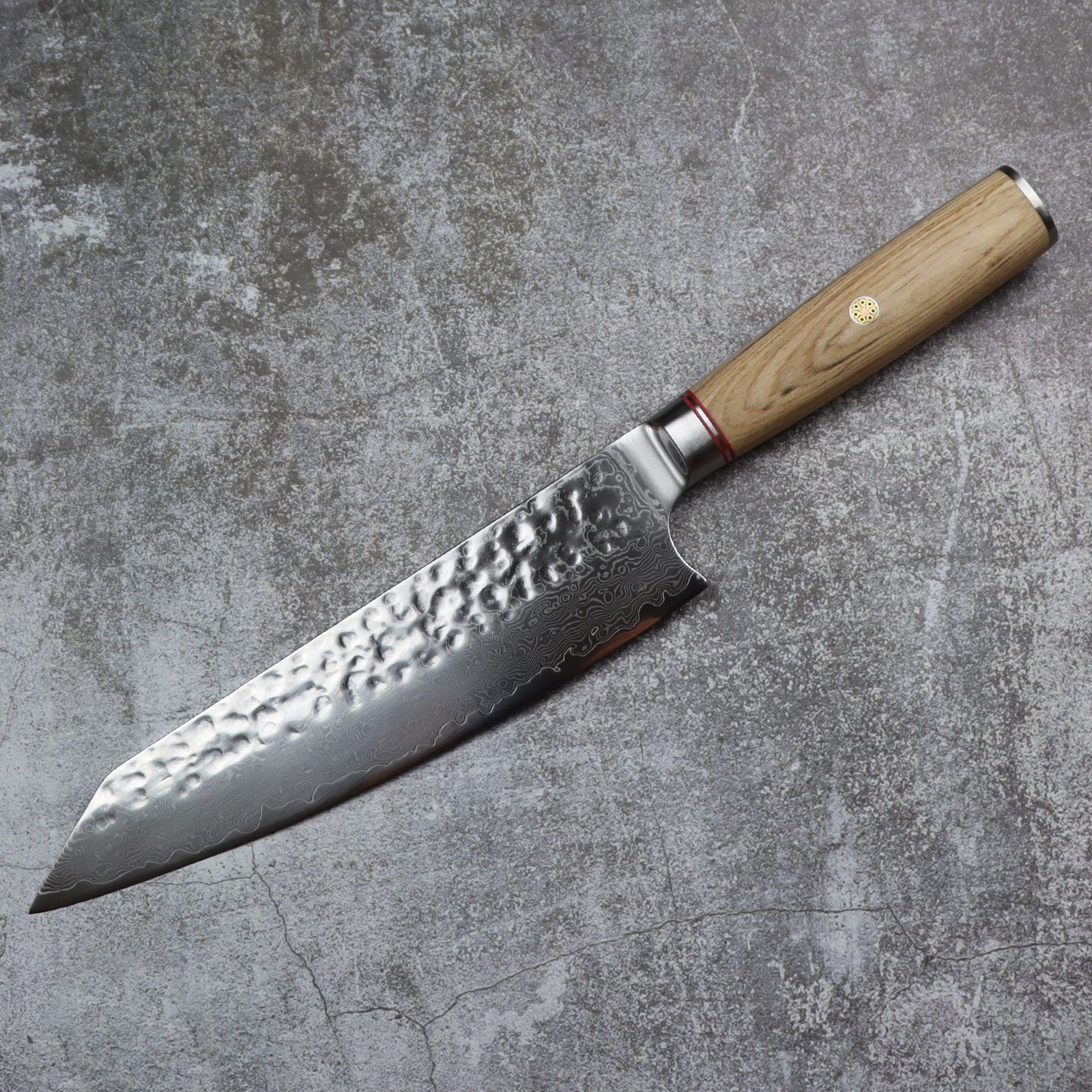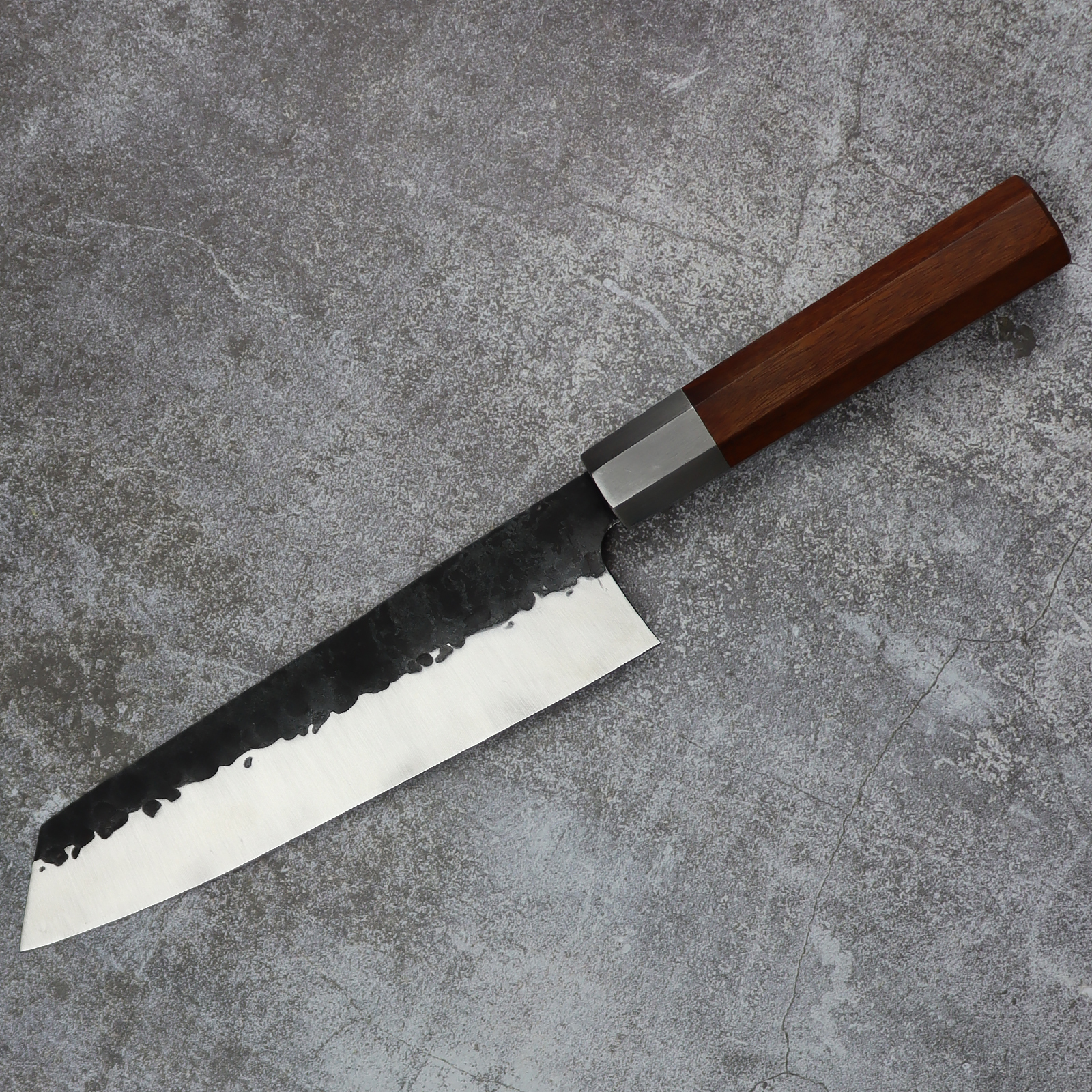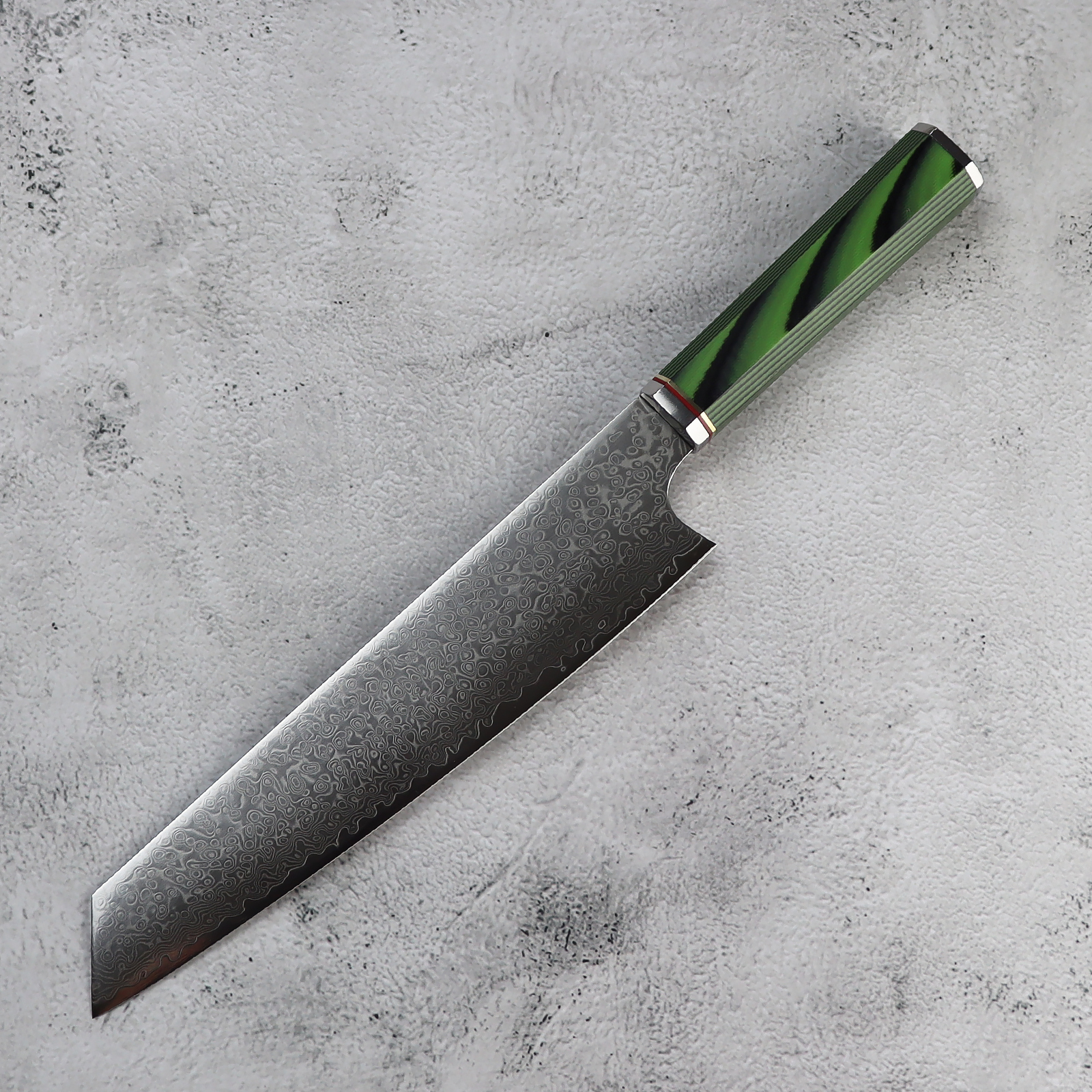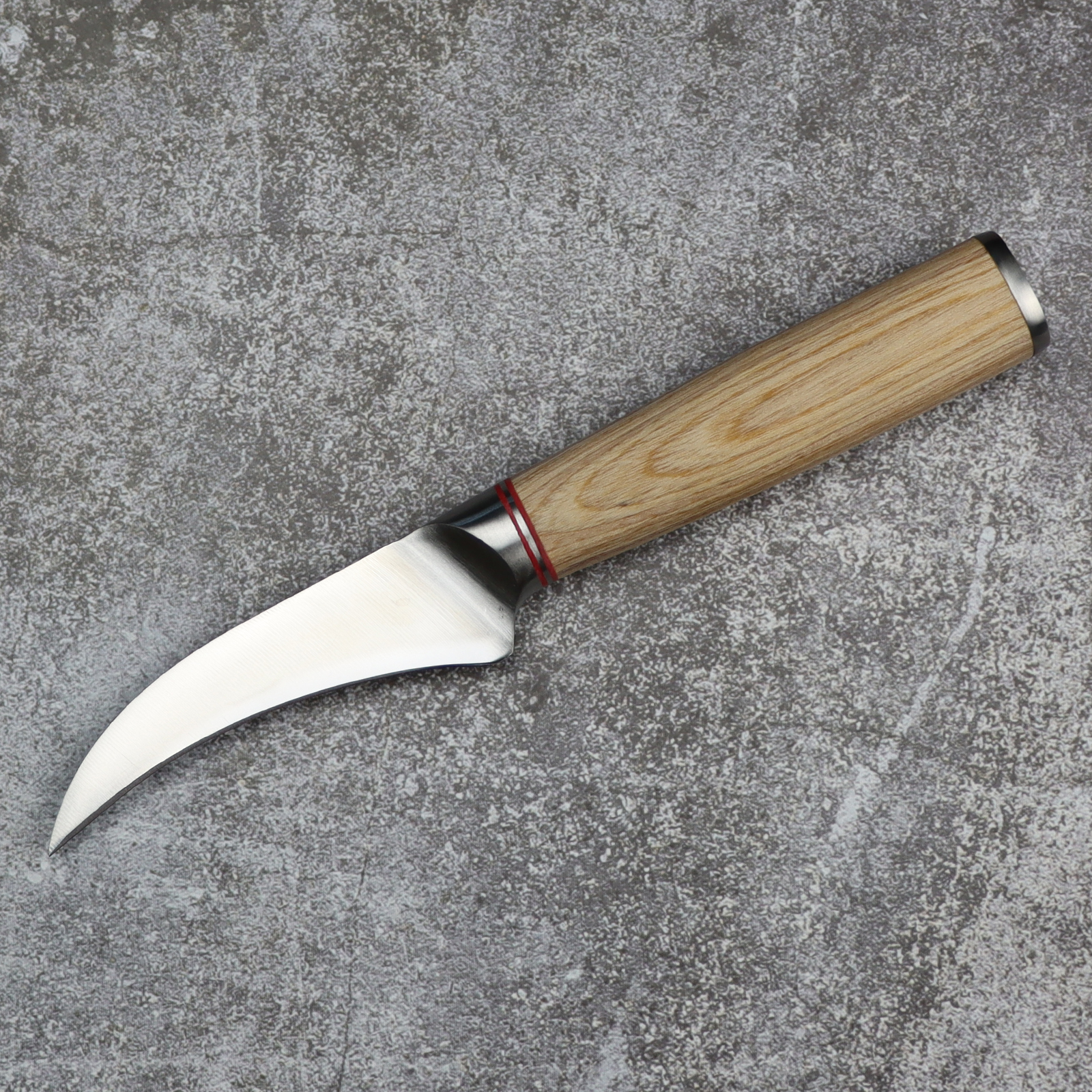The Best Kiritsuke Knives of 2024
Aug 19,2023 | Fzkaly
When it comes to Japanese knives, the kiritsuke knife is one of the most versatile and highly regarded options available. This unique blade is a hybrid of two traditional Japanese knives, the yanagiba and usuba, and is often referred to as the "master chef's knife " due to its ability to handle a wide variety of cutting tasks with precision and ease.
Kiritsuke knives have gained popularity in recent years as more and more professional and home cooks seek out high-quality, reliable knives that can handle a range of different kitchen tasks. These knives are known for their sharpness, durability, and versatility, making them popular choice for anyone who values precision and efficiency in the kitchen.

In this guide, we will explore the world of kiritsuke knives in depth, examining their history, design, and unique features. We will also provide recommendations for some of the best kiritsuke knives currently available and highlight their strengths. Whether you a professional chef or an avid home cook, a kiritsuke knife can be an excellent addition to your kitchen arsenal, and we are here to help you find the perfect one to meet your needs.
What is a Kiritsuke Knife?
A kiritsuke knife is a Japanese-style kitchen knife that is often considered to be a hybrid between a gyuto (chef's knife) and a yanagiba (sashimi knife). It has a long, flat blade with a pointed tip, which makes it well suitable for a variety of kitchen tasks, including slicing, dicing, and chopping.
The kiritsuke knife is believed to have originated in Japan during the Edo period (1603-1868). It was originally used by professional chefs in the Imperial Palace, and its design was based on the Japanese sword, with a long, straight blade and a sharp point. Over time, the design of the Kiritsuke knife evolved to become more specialized for culinary use, and it is now considered one of the most versatile and essential knives in the Japanese kitchen.
Traditionally, kiritsuke knives were used only by the head chef in Japanese restaurants, as they were considered to be a symbol of the chef's skill and authority. However, today kiritsuke knives are more widely available and used by both professional chefs and home cooks.
The blade of a kiritsuke knife is typically made from high-quality steel, which helps to maintain a sharp edge and resist corrosion. The handle is usually made from wood or a synthetic material, which provide a comfortable grip and a well balanced in the hand.
What is a Kiritsuke Knife Used For?
A kiritsuke knife is a versatile kitchen knife that can be used for a variety of tasks in the kitchen. Here are a few tasks that a kiritsuke knife is well-suited for:
Slicing: The long, flat blade of a kiritsuke knife makes it ideal for slicing tasks, such as slicing meats, fish, or vegetables.
Dicing and chopping: The pointed tip of a kiritsuke knife can be used for precision tasks, such as dicing and chopping herbs or small vegetables.
Cleaving: The weight and size of a kiritsuke knife make it well-suited for cleaving tasks, such as breaking down large cuts of meat or cutting through bones.
Julienne and brunoise cuts: The flat blade of a kiritsuke knife can be used for making thin, uniform cuts, such as julienne or brunoise cuts.
In Japanese cuisine, each type of food requires a specific knife for optimal preparation. However, the Kiritsuke knife is the only knife that is considered to be a "master" knife, as it can be used to prepare almost any type of food.
One thing to note is that a kiritsuke knife can be more difficult to use than a standard chef's knife, as it requires a bit more skill and precision due to its flat shape and pointed tip. As such, it may not be the best choice for beginners or those who are not familiar with Japanese-style knives.
Top 5 Kiritsuke Knives
1. 8" Japanese VG10 Chef Knife
This Fzkaly 8" Japanese kiritsuke knife is an excellent entry level chef knife. The overall body of this knife is not heavy, which is very suitable for home cooking enthusiasts and professional chefs. It is made from Japanese vg10 Damascus steel, which has a high level of durability and rust resistance. With a Rockwell hardness rating of 60±2 HRC and a 15° sharpening angle, the knife can maintain a sharp edge for longer periods of time.
The ergonomic epoxy resin stabilized wood handle not only looks beautiful but is also ergonomic, providing a comfortable to hold. The full tang design also adds to the overall balance of the knife.
If you are on a budget and want a versatile chef knife, this knife is the best choice.
Price: $99
Product Details:
Blade Length: 8 in | Handle Length: 5.5 in | Total Length: 13.5 in | Blade Thickness: 0.08 in(2.2mm) | Blade Width: 2 in | Net Weight: 0.41 lbs
2. 8" Damascus Steel Chef Knife
This 8-inch kiritsuke knife is the most sharp and durable Damascus knife series we have ever made. It combines Japanese steel with a polished Damascus blade! This chef kiritsuke knife offers you the best quality in terms of the materials it used and the design it applied.
The 8" kiritsuke knife is forged from vg10 Damascus steel and heat treatment to 60+ HRC. The vg10 steel contains 1% carbon making it hold a sharp edge well, surrounded by layers of softer, more flexible steel, preventing the blade from becoming brittle and prone to chipping, and offering better strength and edge retention.
In addition, the folding produced the characteristic Damascus Water Pattern and the hardwood handle comes in a blend of beautiful colors, giving the knife a unique look that's both elegant and captivating. It is a work of art that adds a touch of beauty to your kitchen. Full tang Integrated molding wood handles are break-proof, beautiful, non-slip, and hygienic.
This professional kiritsuke knife with a premium black knife guard completely covers for safe store and transport of your knives, and edge protection ensures knife blades stay sharp and in perfect condition.
The best-selling series of Japanese chef knives can satisfy every cook nerd or amateur chef. You will never need another knife.
Price: $99
Product Details:
Blade Length: 8 in | Handle Length: 5.5 in | Total Length: 13.5 in | Blade Thickness: 0.08 in(2mm) | Blade Width: 1.89 in | Net Weight: 0.7 lbs
3. Damascus Kiritsuke Chef Knife 8"
The Fzkaly Damascus kiritsuke chef knife is made from premium 67-layer VG10 high carbon steel, going through vacuum heat treatment ensures long-lasting edge retention that make it stand out from other chef knives on the market.
The 15°golden cutting angle, which is a narrow angle, combined with the 108 processes, results in an incredibly sharp blade. The 108 processes used to create this knife involve multiple steps, including forging, quenching, tempering, and polishing, which result in a durable blade that can withstand the wear and tear of regular use. This sharpness makes it easier to cut through various types of food with precision, and it also helps to reduce the risk of slipping and injuring yourself during food preparation.
This kiritsuke knife comes in a leather knife sheath to protect the blade of a knife from damage, and to keep the knife safely stored when not in use.
In addition, this 8 inch kiritsuke knife features a unique and beautiful pattern on the blade, which adds aesthetic value to the kitchen.
In short, Fzkaly 8 inch Damascus Kiritsuke knife is an excellent choice for anyone who values precision, versatility, and craftsmanship in their kitchen tools.
Price: $105
Product Details:
Blade Length: 8 in | Handle Length: 5 in | Total Length: 13 in | Blade Thickness: 0.09 in(2.2mm) | Blade Width: 1.85 in | Net Weight: 0.5 lbs
4. 8" Hand Forged Kiritsuke Chef Knife
If you are in the market for a new kitchen knife, you may want to consider an 8 inch hand forged kiritsuke knife. This type of knife is highly versatile and can be used for a variety of tasks in the kitchen, making it a valuable addition to any home or professional chef's collection.
The Fzkaly 8 inch hand forged kiritsuke knife is the high-quality materials used in its construction. This knife is made from 9Cr18MoV high carbon steel, which is known for its durability and ability to hold a sharp edge over time. Additionally, the knife is forged using the traditional 3-step Honbazuke method, which involves a series of grinding, honing, and polishing steps to create a blade that is sharp and precise.
The blade of the 8 inch hand forged Kiritsuke knife is sharpened to a 14-16° angle, which allows for clean and precise cuts, while the ergonomic ebony handle ensures a comfortable grip during use. The handle is also designed to be moisture-resistant, which can help prevent slipping and reduce the risk of accidents in the kitchen.
Price: $105
Product Details:
Blade Length: 8 in | Handle Length: 5.4 in | Total Length: 13.4 in | Blade Thickness: 0.098in(2.5mm) | Blade Width: 1.9 in | Net Weight: 0.53 lbs
5. 9" Japanese Kiritsuke Chef's Knife
One of the standout features of this 9 inch Japanese kiritsuke knife is its sharpness, which is achieved through a rigorous Honbazuke sharpening process that creates an ultra-sharp edge at an angle of 8-12 degrees. This makes the knife ideal for cutting and slicing of meats, vegetables, and fruits.
The military-grade green G10 handle is ergonomically designed to fit comfortably in your hand and provides a secure grip, even when the knife is wet. The full tang design of the knife ensures that it is well-balanced and provides excellent control.
Additionally, the kiritsuke knife comes with a premium knife sheath to protect the blade when not in use, making it convenient for storage and transport.
Price: $157
Product Details:
Blade Length: 9 in | Handle Length: 4.7 in | Total Length: 13.7 in | Blade Thickness: 0.08 in | Blade Width: 1.88 in | Net Weight: 0.6 lbs
Kiritsuke Knife Buying Guide
If you're considering buying a kiritsuke knife, here are some key factors to keep in mind to help you find the right knife for your needs:
Blade Material
Look for a kiritsuke knife made from high-quality steel, such as VG10 or AUS-10, which helps to maintain a sharp edge and resist corrosion. You may also want to consider the type of steel used in the blade, as some types of steel may be more durable or easier to sharpen than others.
Blade Length and Shape
Kiritsuke knives come in a variety of lengths, typically ranging from 5 to 10 inches. Consider the size of your hands and the tasks you will be using the knife for when selecting a blade length. The shape of the blade is also important - a longer, flatter blade is better for slicing, while a shorter, more curved blade is better for chopping and dicing.
Handle Material and Shape
The handle of a kiritsuke knife should be comfortable to grip and provide a balanced feel in the hand. Look for handles made from durable materials such as Pakkawood or Micarta, and consider the shape of the handle to ensure a comfortable and secure grip.
Price
Kiritsuke knives can vary in price from around $40 to over $400, depending on the quality of the blade and handle materials, and the level of craftsmanship. Consider your budget and what features are most important to you when selecting a kiritsuke knife.
By considering these factors, you can find a kiritsuke knife that fits your needs and preferences, and enjoy the many benefits of this versatile and impressive Japanese-style kitchen knife.
How to Use a Kiritsuke Knife?
Using a kiritsuke knife is similar to using other types of kitchen knives, but there are a few things to keep in mind to get the most out of this versatile Japanese-style knife. Here are some tips for using a kiritsuke knife:
1. Grip the handle: Hold the handle of the kiritsuke knife with your dominant hand and grip it firmly but comfortably. Keep your fingers away from the blade and be careful not to grip the knife too tightly, which can cause strain or discomfort.
2. Use a cutting board: Always use a cutting board when using a kiritsuke knife to avoid damaging the blade and to keep the knife stable during use.
3. Use a rocking motion: For chopping or slicing tasks, use a gentle rocking motion with the blade to help guide the knife through the food. The flat blade of a kiritsuke knife can be particularly effective for slicing meats, fish, or vegetables.
4. Use a precision tip: The pointed tip of a kiritsuke knife can be used for precision tasks such as dicing and chopping herbs or small vegetables. Use the tip of the blade to make small, precise cuts, while keeping your fingers away from the blade.
5. Avoid twisting the blade: Unlike a standard chef's knife, a kiritsuke knife has a flatter blade with less of a curve. Avoid twisting the blade when making slicing or chopping motions to help prevent damage to the blade.
6. Sharpen regularly: To maintain the sharp edge of your kiritsuke knife, sharpen it regularly using a sharpening stone or other appropriate sharpening tool. Kiritsuke knives can be more difficult to sharpen than other types of kitchen knives, so consider having it professionally sharpened if you are not experienced with sharpening Japanese-style knives.
By following these tips, you can use your kritsuke knife effectively and enjoy the many benefits of this versatile and impressive Japanese-style kitchen knife.
How to Care and Maintenance a Kiritsuke Knife?
Proper care and maintenance are essential to keeping your kiritsuke knife in top condition and ensuring its longevity. Here are some tips to help you care for and maintain your kiritsuke knife:
1. Hand-wash the knife: After using your kiritsuke knife, hand-wash it with mild dish soap and warm water, and dry it immediately with a soft towel. Avoid using harsh detergents or leaving the knife to soak in water, as this can damage the blade.
2. Use a honing rod: To keep your kiritsuke knife sharp between sharpenings, use a honing rod to maintain the edge of the blade. Hold the honing rod vertically, and run the blade of the knife along the rod at a 20-degree angle on each side of the blade.
3. Store the knife properly: When not in use, store your kiritsuke knife in a knife block, sheath, or magnetic strip to protect the blade and prevent it from getting damaged or dull. Avoid storing the knife in a drawer or other area where it may come into contact with other sharp objects.
4. Oil the blade: To protect the blade from rust and corrosion, you can apply a small amount of food-safe oil to the blade after cleaning and drying it. This can help prevent rust and keep the blade in top condition.
By following these tips, you can care for and maintain your kiritsuke knife to ensure its longevity and performance in the kitchen. Proper care and maintenance can also help to prevent damage to the blade, keeping it sharp and ready for use whenever you need it.
What is the Difference Between Bunka and Kiritsuke?
Bunka and kiritsuke knives are both Japanese-style knives that have similar characteristics, but there are some key differences between the two.
1. Blade shape: The primary difference between a bunka and kiritsuke knife is the shape of the blade. A Bunka knife has a curved blade with a pointed tip, while a kiritsuke knife has a straighter blade with a more angled or squared-off tip.
2. Blade size: Bunka knives are typically smaller than kiritsuke knives, with blades ranging from 120mm to 180mm in length. Kiritsuke knives, on the other hand, are larger and usually have blades between 180mm to 300mm in length.
3. Blade Thickness: Kiritsuke knives have a thicker blade, with a more pronounced spine than a bunka knife. This makes kiritsuke knives sturdier and better suited for heavier tasks, while bunka knives are more lightweight and maneuverable.
4. Functionality: Bunka knives are ideal for detailed work, such as slicing or chopping small vegetables, herbs, or fruits, and for precise cuts, whereas kiritsuke knives are more versatile and can handle a wider range of tasks. Kiritsuke knives are particularly effective for larger tasks, such as breaking down large cuts of meat, chopping vegetables or fruits, and slicing through larger items like cabbage or melons.
Bunka knives and Kiritsuke knives have similar origins and are both used for various kitchen tasks, but the differences in blade shape, size, thickness, and functionality make them suited to different tasks. Bunka knives are more suited for detailed work, while Kiritsuke knives are more versatile and better suited for larger, heavier tasks.
Conclusion
If you are looking for a versatile and stylish cooking knife to add to your collection, a kiritsuke knife is a great choice. We hope you can learn about kiritsuke knives in this article and choose a kiritsuke knife that satisfies you.

_1728x.jpeg?w=1600&h=1600)
-1_1080x.jpeg?w=1600&h=1600)





